 |
|
Here and There introduces art, artists, galleries and museums around Japan that non-Japanese readers and first-time visitors may find of particular interest. The writer claims no art expertise, just a subjective viewpoint acquired over many years' residence in Japan.
|
|
 |
|
|
 |
 |
Shangri-La in Shigaraki: Ceramics at the Miho Museum
Alan Gleason |
 |
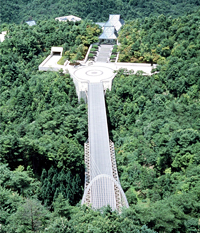 |
|
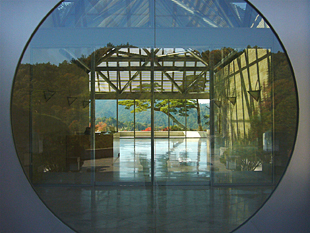 |
| Aerial view of the Miho Museum and its approaching suspension bridge. Photo courtesy of the Miho Museum. |
|
Looking through the entrance of the Miho Museum to the mountains beyond. Photo by Alan Gleason, by permission of the Miho Museum. |
It was my interest in the much-lauded architecture of the Miho Museum that brought me to this isolated corner of Shiga Prefecture, deceptively close to Kyoto but so mountainous that even the highways narrow to a single lane. Designed by the internationally renowned architect I.M. Pei for the religious association Shinji Shumeikai, the Miho is named after Mihoko Koyama, the group's late founder, an avid art collector and an advocate of the spiritual virtues of artistic beauty.
Opened in 1997, the museum sits on a mountaintop -- or rather, buried in a mountaintop -- amid a glorious expanse of forested ridges with nary another man-made structure in sight (aside from the group's headquarters on the next ridge). All glass and white limestone walls, with two of its three stories built into the hillside to minimize its impact on the natural setting, the museum looks something like a benign mother ship from another planet. It also houses a stunning collection of antiquities, not only from Japan but also from ancient civilizations along the Silk Road and extending to Egypt.
Constrained by the rugged topography and strict zoning laws (the site is in the middle of a nature preserve), Pei placed the museum on a piece of real estate that is accessible only by a tunnel and bridge. This dramatic approach is inspired, Pei writes, by the ancient Chinese legend of "Peach Blossom Valley," precursor of the Shangri-La myth. Though tetrahedrons dominate the bright, airy glass-and-steel structure, these harmonize surprisingly well with the elements of Japanese temple architecture to which Pei also pays homage.
As I soon found out, the Miho is not the only artistic attraction in the neighborhood. Just down the road, the small town of Shigaraki boasts a reputation as the source of some of Japan's finest earthenware, dating back to the 12th century. Blessed with clean mountain water and a clay (from the ancient bed of nearby Lake Biwa) full of iron, quartz and other minerals that give the local pottery its unique colors and textures, Shigaraki is ranked as one of the six great ceramics centers of medieval Japan.
Thus it is no coincidence that the Miho has been holding an exhibition on these six traditions, with special attention naturally given to the local product. "Ceramics of Medieval Japan: The Six Old Kilns and Their Environs" runs until 12 December 2010, after which the museum shuts down for one of its lengthy hiatuses until mid-March 2011. Both the show and the museum itself are well worth the long drive or the longer bus ride.
All located in central Japan in regions not too distant from the ancient capital of Kyoto, the "six kilns" (Bizen, Seto, Tanba, Echizen, Tokoname, and Shigaraki) had their heyday during the Kamakura (1185-1333) and Muromachi (1336-1573) periods. Though it was very briefly the imperial capital way back in 742, Shigaraki was one of the last of these districts to begin making pottery. However, the rough and rustic appearance of Shigaraki ware soon found favor with tea ceremony enthusiasts in the capital, particularly as the wabi aesthetic of natural simplicity caught on.
The Miho has devoted an entire wing to this exhibition, offering a rich selection of jars and urns from the "six kilns" as well as several others of that era. Most are impressively large. Before the demands of the cognoscenti for aesthetically pleasing teacups and teapots hit their stride, these sites primarily produced vessels for everyday use -- mortars, water jugs, grain storage containers. The size of the pots makes it easy to examine the extremely variegated patterns of their glazes and other markings. Detailed descriptions of the characteristics of each style -- as well as their mutual influences -- provide an instant education in medieval Japanese ceramics, a subject on which this writer, at least, was woefully ignorant.
Making the trek to the Shigaraki district even more worthwhile is a concurrent ceramics exhibition at the Shigaraki Ceramic Cultural Park. Also open until 12 December, "The Shigaraki Ware: Naokata's Tea Ware and Shunsai's Jar" employs a narrower, but equally gratifying, focus on two contemporary masters. Ueda Naokata V (b.1928) and Takahashi Shunsai (b.1927) are both heirs to multi-generational potters' lineages, and their work reflects that heritage, particularly the influence of the tea ceremony. They also employ the wood-firing methods of the anagama ("cave kiln"), an essential component of the Shigaraki tradition.
The distinctively shaped anagama is a single-chamber kiln, long and tunnel-like (they used to be built into hillsides), with no separation between the firebox and the pottery chamber. It has to be constantly stoked, sometimes for as long as nine days, while temperatures reach as high as 1400 degrees Celsius. Shigaraki is traditionally an unglazed pottery, but the wood ash settling on the clay forms a natural glaze in patterns whose unpredictability is one of the charms of Shigaraki ware. The degree of glazing depends on the placement of the pieces in the kiln relative to the fire. One of the most dramatic sights in Shigaraki is the huge noborigama ("climbing kiln"), a step-like variant on the anagama that marches up the hillside with stoking ports at regular intervals.
Shigaraki boasts Japan's largest noborigama. A fine specimen can also be seen at the Shigaraki Ceramic Cultural Park, whose vast campus includes not only a Museum of Contemporary Ceramic Art (where the aforementioned exhibition is on view) but also an Institute of Ceramic Studies with an active artist-in-residence program. Possibly even better known abroad than domestically, the program has a reputation among ceramicists worldwide and always includes a few artists from overseas who stay for periods from three to six months. Built by Shiga Prefecture in 1990, the Cultural Park is a remarkable facility that merits a visit by anyone interested in Japanese ceramics.
The town of Shigaraki itself is very tourist-friendly, encouraging visitors to stroll through its winding picturesque alleys and visit various potters' workshops. Unfortunately the kilns on view tend to be large operations that churn out either masses of identical flowerpots or hideously kitsch statues of the tanuki (raccoon-dog), the town's ubiquitous symbol. A bit of exploration, however, turns up some hidden gems, like a gallery (occupying a former sewing-machine shop) devoted to the work of young local potters in a decidedly contemporary vein. Indeed, young ceramic artists flock to Shigaraki from all over Japan, drawn not so much by its traditions as by its clay and water. After a visit to this beautiful but often bypassed region, it's easy to see why they stay on.
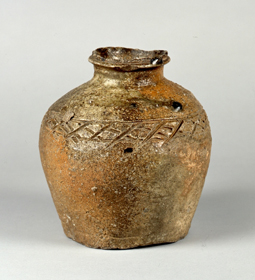 |
|
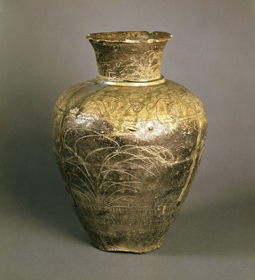 |
Small Shigaraki Pot with Fence Pattern (15th century). From the collection of the Miho Museum; photo courtesy of the Miho Museum.
|
|
Atsumi Ash Glaze Pot with Autumn Grasses (12th century). From the collection of Keio University; photo courtesy of the Miho Museum.
|
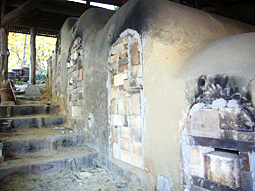 |
|
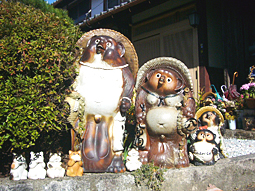 |
The huge noborigama (climbing kiln) at the Shigaraki Ceramic Cultural Park.
Photo by Alan Gleason.
|
|
Some of Shigaraki's all-too-ubiquitous tanuki sculptures.
Photo by Alan Gleason. |
|
|
|
|
|
|
 |
|
 |
Miho Museum |
|
300 Momodani, Shigaraki-cho, Koka City, Shiga Prefecture
Phone: 0748-82-3411
Hours: 9:00 - 17:00 (admission until 16:00); closed Monday (or the following day when Monday is a holiday) and during certain periods of the year (see museum website for details).
Transportation: 50 minutes by Teisan bus from Ishiyama station on the JR Biwako Line. Ishiyama is only a few minutes east of Kyoto. |
|
The Shigaraki Ceramic Cultural Park |
|
2188-7 Chokushi, Shigaraki-cho, Koka City, Shiga Prefecture
Phone: 0748-83-0909
Hours: 9:30 - 17:00 (admission until 16:30); closed Monday (or the following day when Monday is a holiday) and during the New Year holiday.
Transportation: Five minutes by Community Bus from Shigaraki station on the Shigaraki-Kogen Railway, which runs from Kibukawa station on the JR Kusatsu Line; 70 minutes by bus from Ishiyama station on the JR Biwako Line. |
 |
|
 |
|
|
 |
 |
Alan Gleason
Alan Gleason is a translator, editor and writer based in Tokyo, where he has lived for 25 years. In addition to writing about the Japanese art scene he has edited and translated works on Japanese theater (from kabuki to the avant-garde) and music (both traditional and contemporary). |
|
|
|
 |
|